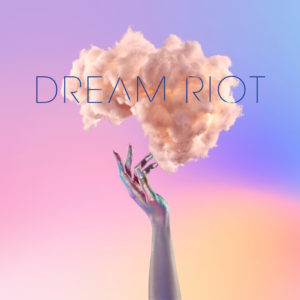
Since the scintillating release of their debut album Crave in 2016, Toronto-based synth-pop stylists Featurette have embarked on a comprehensive journey of artistic self-discovery, exploring even more deeply their varied influences, connecting together on a more profound level as collaborators and working hard to craft songs that resonate on a number of levels, moving the heads, hearts, and spirits of all who hear them.
The dynamic creative duo of vocalist/keyboardist Lexie Jay, and percussionist Jon Fedorsen released their new LP, Dream Riot in January, to critical acclaim. It is a boundary breaking, genre-bending collection of nine songs, each one full of emotional dichotomies and insistently intelligent, sometimes confronting lyrics, majestically bound together by the brightly effervescent and pop-injected compositions for which Featurette has become known and lauded.
It is an experience in clever songcraft, that can be as involving or as entertaining as the listener desires. What it can never be accused of is being throwaway or easily disregarded.
Dream Riot is much more than just a collection of songs penned over a period of time. It is a revelatory collection of music that often digs well below the surface into the churning, roiling emotional tumult of mind, body, soul and spirit, as communicated through the darkly sweet, melodic, yet heavily-laden lyrical textures created by Jay.
“It’s a really personal record for us. As we were writing these songs one by one over the period of time that it took to put the album together, I don’t think even we realized the extent to which they are so personal. So many times you’re writing a song and you’re like, ‘okay, that’s a really great song, and this melody is really working for me,’ and then you get to the lyrics and you ask yourself, what’s the crux of what I am trying to say here,” she explained.
“When you step back later and look at the songs as a collection, that’s when you realize there is a thread running through them. We don’t have these master plans from the start, if you’re making art as you go. It’s really only now, when we’re putting the final product together that you realize the songs are dealing with some pretty deep-rooted issues in society right now, even songs like the first song on the album, Won’t Love You. It is about a relationship, obviously, but it’s not just about a relationship, it’s the female narrative on the relationship and what her perspective is, going through some tumultuous times and maybe even some abusive times. Going forward to some of the other tracks, we’re dealing with climate change, and social media’s affect on mental health, and finding and embracing the dark parts and the dark side of yourself, and also bullying in high school and how that affects you growing up with anxiety and depression.
 “Even the lightest of the songs, You Do You, which is by far the most positive song we’ve ever written, that one came out of this story about bullying and anxiety that came directly from one of our fans that was presented to me. So even the most beautiful and positive natured song that we’ve written is still born out of this pain and sadness. So, we’re directly reflecting what’s affecting us in our lives and what’s affecting so many people in society on this record. I think it’s really interesting that it came out that way because we didn’t set out to write a commentary on modern society and have songs about so many big issues.”
“Even the lightest of the songs, You Do You, which is by far the most positive song we’ve ever written, that one came out of this story about bullying and anxiety that came directly from one of our fans that was presented to me. So even the most beautiful and positive natured song that we’ve written is still born out of this pain and sadness. So, we’re directly reflecting what’s affecting us in our lives and what’s affecting so many people in society on this record. I think it’s really interesting that it came out that way because we didn’t set out to write a commentary on modern society and have songs about so many big issues.”
Fedorsen said that while there was no direct attempt at being ‘political’ or any sort of social commentary affixed to the compositions on Dream Riot, he is happy that the songs do have something of substance to say, and are flexing some lyrical muscle about many of the issues plaguing the modern world.
“I don’t feel that there’s a lot politically happening in music. Man, there’s a lot of crazy things happening in the U.S. and in the rest of the world. And I believe there are two responses to all of this. One is to gloss over it saying everything’s great, let’s go dance around and party and do cool things. But we’re taking the other approach: we’re affected by all of this and we can’t help but comment on it,” he said, with Jay adding that it’s the reason why Featurette chose to release a nine-song album, as opposed to a more truncated EP.
“What we wanted to say couldn’t be said in an EP. It couldn’t have been said in less than nine songs and if we did any more, I think we would be reaching to find complimentary subject matter. These are the nine songs that best represent where Jon and I are right now as people, as artists, as musicians. And it’s full of light and dark and lots of shades of grey. There are times where there is a sense of discomfort in the songs and that’s deliberate, in the way it came out sonically, especially with the vocals,” Jay explained.
“This album has grit to it, and that’s where the indie side of our nature comes in. Because we are an electro-pop band for sure, and some of these songs, if music business politics weren’t at play, I think some of them could go head to head with what’s on pop radio right now. I really believe in these songs, but that’s not the way the world works. But regardless of that, we don’t make music that’s pretty for pretty’s sake. If it’s pretty, it’s because in that moment we wanted to portray that colour of music. Then in the next moment we probably would contrast that with something that’s quite ugly or discordant, or something that sounds really beautiful, but the lyric is something really difficult to digest.
“I think the catch phrase or elevator pitch that we came up with for our music was dark stories wrapped in bubble gum beats, and I think that fits so well, because to the surface listener, the songs are very palatable and very memorable and get on things like It’s A Bop on Spotify, but then you really listen to it and it’s like, ‘oh yeah.’”
White Rabbit is one of the most insistently powerful songs on the album, both for its mesmerizing musicality as for it’s arresting lyrics, which have been superficially interpreted by some reviewers as being about a toxic relationship between two people, but are in fact a much more broader commentary on the toxicity humanity has been exhibiting towards the earth itself – yet even there, the scope of the commentary is still left greatly to the imagination of the listener.
“We don’t want to be too specific in our message because we want other people to relate to it by putting their own lives into their interpretation of the songs,” said Fedorsen.

“And White Rabbit is an interesting story. Often when we are doing our writing, we will do a fairly rough demo, like it will be piano parts or a plug-in or a simple synth line and Lexie will sing over it and then we won’t commit to it for a while. I think the original demo for White Rabbit, I tracked one vocal line and it was a synth and a bass and a very simple shuffly drumbeat and we gave it to Mark Koecher, our producer, and said, ‘wow, this is dope. I think we can do a lot with this.’ He took the original sounds and he chopped them up and added all that space in between the notes, and we really took off from there. And I remember doing all the vocal stacks with Lexie and she was loved doing that, making choirs and layering harmony on top of harmony. When we finished it, we felt it was the biggest homage to our electronic music influences, and maybe less to our poppier stuff, and maybe that’s why it’s my favourite song on the album.”
“With White Rabbit, we didn’t want to just hit people over the head by saying the planet is dying. You’ve got to make it about something very universal. Someone thought it might be about a relationship where the other party is not welcome any more, but it’s totally not about a personal relationship; it’s about our relationship with the planet. It’s not two people, it’s us and the planet on which we live,” asserted Jay.
“When we first heard Mark’s mix it was met with a lot of silence because we were like, ‘whoa, can we even do something like this? Is the even allowed, because it feels hella uncomfortable.’ Whether you like the music or not, when you listen to that song, you will feel something. It’s very jarring. And it’s the darkest song as well on the album. Climate change, to me, is the most important topic of all the topics we hit on the album. I think we showed White Rabbit a lot of love and then when it came together visually for the video, it was like a home run for us as far as representing Featurette and what we want to do with this band – what we set out to do originally.”
Videos are important to the overall Featurette presentation, with the band heavily involved in all aspects of production, developing a feel and look that is individual for each video treatment, but still infused with the off-kilter and attention grabbing emotional cacophony.
“The only video I would say we weren’t involved in from conception was Don’t Know Me Without You, and the dance troupe part in Million Things. But as far as all the visual things in all the rooms in Million Things, I was a huge driving force behind that storyboarding. Once we got the initial ideas for that I sat down over a nice head of cauliflower in a hipster Toronto café and talked to director Ian MacMillan, and we jointly looked up the images online that we wanted to draw from and also bounced storyboard ideas back and forth until we were all happy with it. For Don’t Know Me Without You’s video, we had a real budget because of Factor, so we decided to do something crazy, so Ian came up with the car chase and I had to make that fit within our narrative which challenging, but then actually ended up being uniquely beautiful,” Jay explained.
“And then there are other videos like the one for White Rabbit, where we had $300 and just two days. Mark, who is not normally our videographer at all, helped us out with that one, bringing in a drone. It was so last minute and so crazy. Even the location was just luck as that hole in the ground you see is actually Mark’s future house. It just so happened that they had been held up for a couple of months, so we happened to have this three day window of having this property not filled in by concrete. That’s one extreme where its all by the seat of our pants and then there the video for You Do You where I did so much pre-planning, from the conception and storyboarding to sending that out to the director, to working on set design, and all the pre-production, to costuming, wardrobe, casting, scouting for locations – all of it. And that’s because we care so much about everything that we do.”
Fedorsen continued along the same thought as he spoke of why Featurette puts so much attention and care into videos as they do the writing and recording of the music itself.
“The danger is telling too much of what the song is about in the video, which is tricky. We do actually write a description for each of our videos now as to what our inspiration is, to give it context. We want to imagine what it could be for each viewer. When Featurette started, I always wanted it to be a band that was allowed to make music in a manner that was cinematic and that our songs and videos and even our stage presentation were not bound by the X, Y and Z of how things are normally done. We want the presentation to be cinematic, so I think videos make so much sense for us and are so important for us because it’s the visual manifestation, especially for Dream Riot, of all the songs. We spent so much time on the sounds of the album, we felt that we had to do it justice visually too. So, in some areas we may have gone overboard but we kind of like doing that, being a little overboard and outside the normal boundaries is kind of our thing,” he said.
Starting Feb. 28 in Nanaimo, Featurette is embarking on a short western Canadian swing that will see them play in Victoria, Vancouver, Calgary and Edmonton, before a home date in Toronto at the Rivoli on April 17. For more information on upcoming tour dates, Dream Riot and more, visit http://featurettemusic.com.
- Jim Barber is a veteran award-winning journalist and author based in Napanee, ON, who has been writing about music and musicians for a quarter of a century. Besides his journalistic endeavours, he now works as a communications and marketing specialist. Contact him at jimbarberwritingservices@gmail.com.
SHARE THIS POST:
